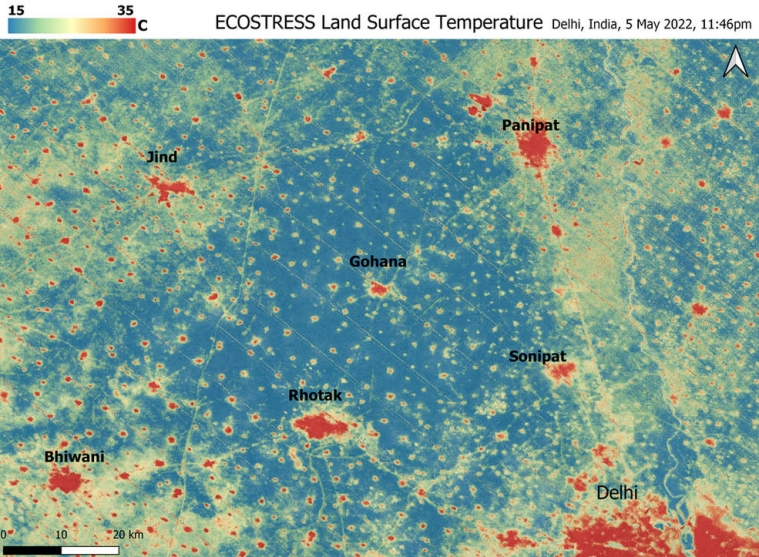
So, what are urban heat islands, and why are they caused? Are there ways to mitigate them? The Indian Express explains:
What is an urban heat island?
An urban heat island is a local and temporary phenomenon experienced when certain pockets within a city experience higher heat load than surrounding or neighbouring areas on the same day.
For example, a greener locality like Pashan in Pune often records cooler temperatures than urban areas like Shivajinagar, Chinchwad or Magarpatta.
The variations are mainly due to heat remaining trapped within locations that often resemble concrete jungles.
The temperature variation can range between 3 to 5 degrees Celsius.
Why are cities hotter than rural areas?
Rural areas have relatively larger green cover in the form of plantations, farmlands, forests and trees as compared to urban spaces. This green cover plays a major role in regulating heat in its surroundings.
Story continues below this ad
Transpiration is a natural way of heat regulation. This is the scientific process of roots absorbing water from the soil, storing it in the leaves and stems of plants, before processing it and releasing it in the form of water vapour.
On the contrary, urban areas lack sufficient green cover or gardens and are often developed with highrise buildings, roads, parking spaces, pavements and transit routes for public transport. As a result, heat regulation is either completely absent or man-made.
Physics teaches us that black or any dark coloured object absorbs all wavelengths of light and converts them to heat, while white reflects it.
Cities usually have buildings constructed with glass, bricks, cement and concrete — all of which are dark-coloured materials, meaning they attract and absorb higher heat content.
Story continues below this ad
Thus forms temporary islands within cities where the heat remains trapped. These are not the typical islands around water bodies, but urban heat islands that record higher day temperatures than other localities.
Where were heat islands experienced recently?
On May 15, Najafgarh and Mungeshpur localities in Delhi recorded maximum temperatures of 49.2 degrees Celsius, whereas other locations in the city recorded lesser temperatures, like Mayur Vihar (45.4 degrees Celsius), Lodhi road (45.8 degrees Celsius), Palam (46.1 degrees Celsius), Ayanagar (46.8 degrees Celsius) and Delhi Ridge (47.2 degrees Celsius).
Experts say these temperature differences are due to variations in heating over highly urbanised and semi-urbanised areas and the comparative availability of open and green spaces in the surroundings. Besides, urban meteorological processes act completely differently from country-side or semi-urban/rural areas.
How can urban heat islands be reduced?
The main way to cut heat load within urban areas is increasing the green cover; filling open spaces with trees and plants.
Story continues below this ad
Other ways of heat mitigation include appropriate choice of construction materials, promoting terrace and kitchen gardens, and painting white or light colours on terraces wherever possible to reflect heat.
What has NASA said on urban heat islands in India?
NASA recently pointed out heat islands in urban parts of Delhi, where temperatures were far higher than nearby agricultural lands.
NASA’s Ecosystem Spaceborne Thermal Radiometer Experiment (Ecostress) captured an image shortly before midnight of May 5, covering an area of about 12,350 square kilometres, which showed a large red patch around Delhi and smaller red patches around neighbouring cities of Sonipat, Panipat, Jind and Bhiwani. These red patches, implying higher temperatures, were the heat islands, while the rural areas around the cities witnessing lower temperatures.
 The heat islands in urban parts of Delhi, as recorded by NASA’s Ecostress (Source: NASA)
The heat islands in urban parts of Delhi, as recorded by NASA’s Ecostress (Source: NASA)
“Nighttime temperatures in Delhi and several smaller villages were above 95 degrees Fahrenheit (35 degrees Celsius), peaking at about 102 degrees F (39 degrees Celsius), while the rural fields nearby had cooled to around 60 degrees F (15 degrees Celsius),” NASA said in a statement.
Story continues below this ad
Ecostress is an instrument with a radiometer which was sent onto the International Space Station in 2018. It can measure temperatures on the ground, as opposed to the air temperature. Ground temperatures are likely to be higher during the day than air temperatures and almost the same during the night. Primarily, Ecostress is tasked with measuring the temperature of plants and understanding their water requirements and the impact of the climate on them.
Newsletter | Click to get the day’s best explainers in your inbox



 The heat islands in urban parts of Delhi, as recorded by NASA’s Ecostress (Source: NASA)
The heat islands in urban parts of Delhi, as recorded by NASA’s Ecostress (Source: NASA)




































